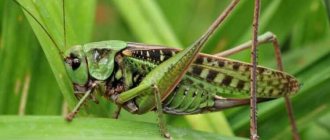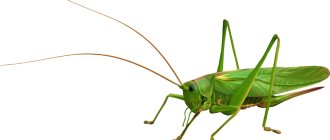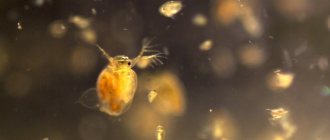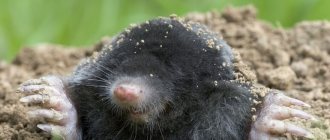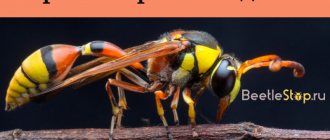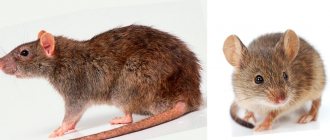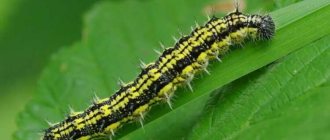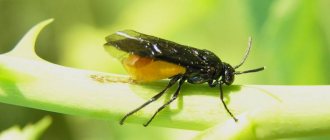Review author: “ZooVita”
Probably everyone has heard a grasshopper chirp at least once. When catching a grasshopper, most people are accustomed to thinking of a small green insect. However, this amazing representative of the Orthoptera order is distributed almost everywhere, and each subspecies has a lot of phenotypic features.
More details and characteristics of each variety can be noted in the photos of grasshoppers presented in entomological manuals.
A little anatomy
The body can be from 1.5 to 15 cm in length. It can be conditionally divided into three parts: head, chest, abdomen. There are two pairs of wings. On the massive head there are organs of touch (whiskers) that are longer than the body. The eyes are big.
Males are smaller than females. 3 pairs of legs. The chirping sound is made by the elytra, one of which is a “bow”, the second is a “resonator”. Each variety has its own sound scale. The ears are located on the front legs.
If you carefully look at the photos of grasshoppers, you can see a lot of interesting and unusual things.
Larva
Grasshoppers are insects with incomplete metamorphosis, that is, their larva resembles a smaller copy of the adult, only without wings. The ancient genus of Orthoptera has reached our days from distant times, when the coal seams were formed, and has not changed at all since then.
Grasshopper larva
The life of a green grasshopper does not begin in a meadow, but in the soil, at a depth of about 5-7 centimeters. There the insect emerges from the egg and begins the difficult journey towards the sun. The first instar larva (that is, before the first molt) is half a centimeter in size and is dressed in a whitish case that fits tightly, with a bubble in the back of the head. Moving like a worm, it moves upward, and the bubble, swelling and falling, serves to push apart the soil particles. Having encountered a stone on the way, the larva is doomed, because it can only move in a straight line. There are about 60 eggs in the clutch, but only the strongest and luckiest, about 10%, come to the top.
At the top, the insect takes off its temporary “space suit.” After waiting a little for the chitinous covers to harden under the sun, the larva begins to feed. She prefers the most tender parts of the leaves. During the season, the insect molts several times, increasing in size until it reaches the adult stage. As the larva grows, its menu also undergoes changes.
In middle age, the basis of the diet consists of grass seeds in the stage of milky ripeness, but the young grasshopper already shows predatory tendencies, destroying clumsy aphids and clutches of other insects encountered along the way. Hairless caterpillars are readily eaten. Gradually, the jaws become stronger, and older larvae easily cope with small locusts.
Chirping, what is this?
Above we briefly explained how a grasshopper chirps. Now let's look at the process in a little more detail.
The left elytra is equipped with a membrane with a special serrated vein, which is called stridulatory. It is she who plays the role of a “musical reed”.
On the right there is a resonator membrane. To produce a chirping sound, you need to vibrate the elytra.
The melodies and volume are different, depending on the type of insect. The sounds are most often made by the male. However, there are several species where the female shows her musical abilities.
Short description
Grasshoppers (lat. Tettigonioidea) are arthropod insects, which belong to the superorder Neoptera, order Orthoptera, suborder Long-whiskered, superfamily Grasshoppers.
There are approximately 7,000 species of these insects. They are found on the territories of all continents, with the exception of Antarctica.
Such diversity can often confuse even an experienced entomologist, who will find it difficult to accurately determine which species a particular individual belongs to.
Most species have an oblong body, on which there is a head compressed on both sides with two oval-shaped faceted eyes. Insects are endowed with powerful gnawing jaws, with the help of which they deal with prey, tearing off particles of food. The body length of a grasshopper depends on its species and is 1.5-14 cm.
Thanks to three pairs of legs, it is able to perform various functions: with the help of the two front legs, walking is carried out, and the muscular rear ones are designed for jumping. The insect pushes off with great force, which allows it to jump distances that exceed the length of its own body by 15-20 times. The antennae of grasshoppers are very sensitive. They perform the function of touch, and their size in many species is much greater than the length of the body.
Habitats and lifestyle features
The lifestyle of grasshoppers depends on their species. For example, insects living in swampy or desert areas do not have a green color, while for tropical inhabitants this color is camouflage, allowing them to remain unnoticed in the grass. Some species of grasshoppers live in caves. They do not have wings, but they have long legs and sensitive antennae in the form of antennas.
Field crickets, which live in Africa, are not able to disguise themselves as ants. This is a very big drawback, since in that area an attack by a large ant army is not uncommon. There is another type of South African cricket, which is similar in appearance to a pebble. Having little resemblance to a living creature, such a grasshopper remains invisible to predators. Some grasshoppers can secrete a liquid with a specific odor that repels hunters of small insects.
Appearance
Externally they also differ. Grasshoppers are most often green. This color helps them camouflage themselves in foliage to make it easier for them to forage for food.
They have a movable head with sharp jaws. Powerful hind legs, short front legs. Incredibly long whiskers, which locusts do not have.
The body of the locust is brown or yellow, although it can be green, brown, or gray. The antennae are short, as long as the head. The hind legs are shorter but stronger. We hope it is now clear how to distinguish a grasshopper.
Nutrition
Among the small insects that inhabit the Earth, there are also cruel predators. Grasshoppers are one of them. These are natural, skilled hunters. They try to grab their prey with lightning speed, using their forelimbs. They feed on larvae as well as small insects, eating small locusts, mites and aphids.
Grasshoppers also eat beetles, butterflies, and caterpillars. In cases of shortage of other types of food, especially if they find themselves captive in a confined space, they are capable of attacking their own relatives in a wave.
Flowery grasshopper eating leaves
And sensing luck, the stronger will feast on the weaker with appetite, without hesitating at all. To get their required dose of nutrients, salts and protein, these insects are able to consume carrion and feces.
Grasshoppers can be attracted to plant leaves from plant food, but only on young shoots. There are species for which this type of nutrition is the main and even the only one.
However, in this case, the insatiability of grasshoppers sometimes harms cultivated and forest plants. But by eating harmful insects, in particular the Colorado potato beetle, which destroys potato plantings in huge quantities, grasshoppers turn out to be very useful.
Reproduction and lifespan
Insects living in the temperate climate zone begin to “make friends” in late spring and early summer. During this period, you can hear the roulades of the males.
Their seminal fluid is stored in a capsule covered with a nutrient mixture.
During mating, they attach the capsule to the female's abdomen. She begins to feast on the bait mixture, and at this time fertilization occurs.
Then a clutch is made, which can contain from 100 to 1000 eggs. It can be found everywhere: on branches, stems, bark, etc.
After a while, larvae appear, similar to grasshoppers, only miniature. They grow and shed. Shedding can be 4-8 times.
At this stage, wings appear. After the last molt, the grasshopper waits for the wings to be fully restored and sets off on the journey called life.
Do you want to know how long a grasshopper lives? Taking into account all stages of development, its life expectancy is just over a year. If you keep a record from the moment of “adult” life, then it turns out to be only one summer. As soon as cold weather sets in, the insect dies.
Secrets of the one sitting in the grass
Externally, grasshoppers are very similar to locusts. Main differences: locust whiskers are short, females do not have an ovipositor. Grasshoppers do not form a herd form; they bring more benefit to agriculture than harm.
The most typical representative of this genus for our latitudes is the green grasshopper (Locusta viridissima L.). The spectacular large insect lives where there is high grass. The protective coloring makes it invisible - when the grasshopper does not move or sing, it is not easy to notice. Along the sides of the insect’s body there is a lighter stripe, similar to a grass stem, which camouflages it even better. The female differs from the male in its larger size and the presence of a saber-shaped ovipositor.
Female green grasshopper
The grasshopper is secretive and timid. Disturbed, it either falls into the thick grass or jumps, opens large transparent wings in the jump and flies away from its pursuer. It is quite difficult to observe grasshoppers in nature, so much of their life remains “behind the scenes” for people, including their feeding habits. Meanwhile, this creature can transform in an amazing way: from a vegetarian it turns into an agile predator, capable of catching a victim twice its size.
Photos of grasshoppers
Menu
What grasshoppers feed on crops harms farmers. They love to eat grape buds and flowers. Did you know that the grasshopper is primarily nocturnal? But during the day he hides in secluded places, and comes out to hunt only at dusk. By the way, he is not such a harmless insect. In nature, grasshoppers are actually predators. And although their diet includes plant foods, the main menu consists of small butterflies, mites, and caterpillars. Hiding in ambush, the grasshopper waits for prey and with its powerful paws that are in front, grabs the victim. Then the “hunter”, using strong jaws, shreds the caught insect and then eats it. The size of the prey matters; the victim should not be larger than the “hunter”. Grasshoppers, cannibals, do not exclude their small brothers, as well as their larvae, from their menu. They are not gourmets, so they eat everything that comes their way. As it turned out, plant and animal food is what grasshoppers eat.
Another very interesting fact. If you think that everything that jumps green or gray at you when you walk on the grass is grasshoppers, then no. They are often confused with fillies or representatives of the Locust family. He himself hid in a shelter and quietly dozed.
The life of grasshoppers is very short-lived, about one year, including the larvae.
Symbolism
Grasshoppers are sometimes used as symbols. He was the symbol of the polis in Athens. Native Athenians wore gold brooches depicting a grasshopper to show pure Athenian ancestry without foreign ancestors.
Another symbolic use is Sir Thomas Gresham's gilded grasshopper in Lombard Street, London, dating from 1563. The building was for some time the headquarters of the Guardian Royal Exchange. But the company refused to use the symbol for fear of confusion with locusts.
Like pests
Grasshoppers eat large amounts of foliage both as adults and during development. They can become serious pests of dry lands and prairies. They thrive in warm, sunny conditions, so drought encourages population growth.
One dry season is usually not enough. Several successive dry seasons, especially if the intervening winters are mild, favor the survival of large numbers of nymphs.
It is possible to get rid of grasshoppers by manipulating the environment. The shade of trees prevents their spread. Insecticides can be used, but adults are difficult to kill because they move quickly.
Some types of grasshoppers, such as Chinese rice grasshoppers, are pests in rice fields. The locust invasion has devastating consequences for the population, causing famine. Mentioned in the Koran, Bible.
The insects are responsible for cholera epidemics caused by locust carcasses that drowned in the Mediterranean Sea and decomposed on beaches. Timely application of pesticides prevents the formation of nomadic bands before dense aggregations of adults are formed.
In addition to traditional control using contact insecticides, biological methods of pest control are used. The fungus Metarhizium acridum specifically attacks grasshoppers and has been used with some success.
Adults
By July, the larva molts for the last time, becoming a full-fledged winged insect. On hot days, they tend to be motionless, with their forelimbs extended. This is similar to the pose of their close relative, the praying mantis. Like it, the grasshopper has grasping tentacles on the inside of its legs, but they are smaller. If a hunter comes across a careless victim, the grasshopper quickly kills it with a bite to the back of the head, eats it, leaving only the wings and head, and freezes again.
Males sometimes sing short trills in an attempt to win over females; most often, courtship occurs at midnight. The sound that a grasshopper makes is like hitting a metal surface, sounding barely audible, as if from afar. That is why the insect got its name.
Before sunset, the activity of adults increases . The grasshopper is helped to navigate in the dark by its whiskers and keen hearing. Some victims are twice the size of the hunter, but a powerful bite to the back of the head leads to the death of any of them. Even well-flying cicadas cannot escape. In areas with sandy soil there is another hearty food - khrushchi. At night, they begin to fly out en masse, and most of them, appearing on the surface, immediately turn into prey.
For some reason, only females show predatory tendencies, while males have more of a sweet tooth. Fallen berries or fruits are the main delicacy; the stronger individual does not allow competitors to eat, trying to drive them away with blows from the hind limbs. If the hunt is unsuccessful, the insect is content with plants. That is, the grasshopper is an omnivore.
Habitats
The grasshopper can be found in every corner of the earth except Antarctica. He prefers green edges, valleys, gorges in which lush grass grows. In Central Asia, it lives high in the mountains, trying to hide among plants from the scorching sun.
In the Alps, the grasshopper chooses high-mountain meadows, loves open spaces, and avoids forests. You can meet a grasshopper in the Far East and Africa, in Denmark and Finland, in England and in the sultry jungle.
Adaptation to the environment
Many animals eat grasshoppers, so they have to fight for life in all sorts of ways. The main defense is their powerful jumping legs, the ability to hide, the dismembering protective coloring, the spines with which they signal to their relatives about a threat, and the ability to bite. For example, a leaf grasshopper can bite through human skin until it bleeds. But there are also lesser-known protection options:
- When in danger, some species tear off their limbs. Insects easily part with one or two legs.
- Protective coloring may seem like a primitive protective method. Insects in nature also use other complex camouflage options. Mimicking leaves is a favorite technique that is often used. For example, the species Cycloptera elegans strongly resembles a dry leaf.
- Another genus Pterochosa is similar in color, pattern, and position of the veins to a withered and discarded leaf. There are spots on the wings that resemble pest damage to the foliage.
- Some varieties imitate a twig that sticks out of the trunk or lichen growths. There are species that can scare away the enemy with a squeal or cause disgust by belching their gastric juice.
Loud-voiced singer
The grasshopper chirps on a cool day or in the evening, and occasionally at night. This happens thanks to its elytra, which act as a kind of musical instrument.
As a result of vibration, a sound appears that intensifies when the insect's wings rise. Each type of grasshopper has its own melody.
It is called the music of nature. During the mating season, males make a peculiar crackling sound, which females cannot do.
Sensing danger, the grasshopper immediately falls silent. This is how he escapes from his enemies. To hear a clear-voiced singer, you should not talk loudly or make sharp sounds. Listen to the silence and you will hear the trill of a grasshopper.
Interesting Facts
The most interesting fact is that certain species can only be female. Moreover, these females lay eggs. However, they also produce exclusively females.
Some species of grasshoppers are popular food items in most Asian countries. They contain large amounts of protein and other nutrients. For European people, eating insects is considered something repulsive and causes strong disgust. But many peoples are happy to feast on such healthy and wholesome food.
Main dishes:
- insects fried in sunflower oil with garlic;
- fried dried grasshoppers taste like peanuts;
- deep-fried insects;
- grasshoppers in marinade;
- pancakes from assorted insects.
To catch the required number of grasshoppers, you need to go out with a net to a lawn with tall green grass.
The nutritional value of the insect is approximately 155 kcal per 100 g of product. The average amount of protein is much higher than in meat products and is 30 g.
In the near future, locusts, grasshoppers, mealworms, peacock and silkworm larvae, and crickets may very well become common and popular food items. Already today, many well-known manufacturers add insect flour during the production of products, thereby increasing its nutritional value and energy value.
Phylogeny, species
They belong to the suborder Caelifera. It includes about 2,400 genera and 11,000 known species. There are probably many undescribed species, especially in tropical rainforests. They have a predominantly tropical distribution. Found all over the world. They are almost exclusively herbivores.
The most diverse superfamily is Acridoidea, with about 8,000 species. The two main ones are Acrididae (grasshoppers and locusts) with a worldwide distribution, Romaleidae (lubber grasshoppers), found mainly in the New World.
Ommexechidae, Tristiridae - South Americans, Lentulidae, Lithidiidae, Pamphagidae - African. Paulinids are nocturnal and can swim or walk on the surface of the water.
Lentulides are wingless. Pneumorids are native to Africa, especially the southern part, and are distinguished by a swollen abdomen in males.


